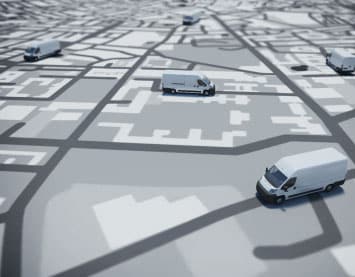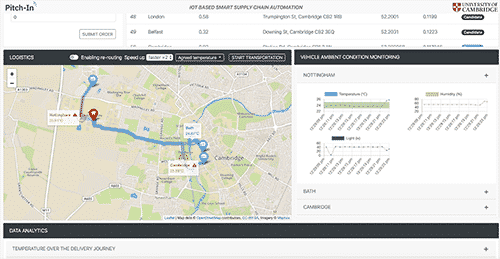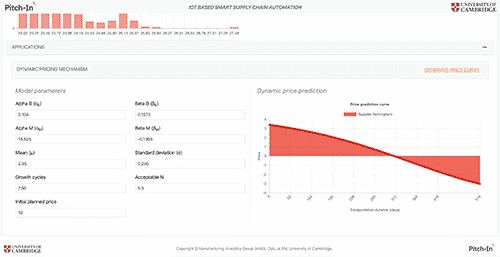Insights
An IOT-based smart supply chain automation system
This article gives an overview of a demonstrator that has been developed by the IfM’s Manufacturing Analytics Group as part of Pitch-In, a project aiming to extract benefit for the UK from Internet of Things technologies and expertise via wide-ranging collaboration between academic institutions and the public and private sectors.

Today supply chains have become very complex systems with multiple organisations being dependent on each other. Typically we would order from a supplier who would then order from someone else, or involve third party logistics companies without our explicit knowledge. However, their actions might end up impacting the delivery times or even condition of the products ordered.
There is a need to create systems that allow for rapid exchange of data over the end to end supply chain to create better visibility and traceability. Although e-markets and electronic data exchange systems have been around for a while, not all stakeholders involved in a delivery chain will have them, or the systems they have may not be ‘talking’ to each other. Emerging industrial trends such as distributed manufacturing and mass customisation necessitate rapid new supply chain configurations and quick and reliable data exchange between partners. There is a lack of interoperable systems and little incentive for individuals to invest in their systems “talking” to one another.
We are working towards creating a platform that allows this “talking” to happen autonomously through the use of IoT and agent technology. Ultimately we would like agents to take over the mundane tasks of supply chain monitoring, adjust orders, learn to negotiate prices, and plan for the future. The system we are demonstrating allows each stakeholder in the supply chain to be represented by a software agent, with its own goals and tools for achieving those goals autonomously.
About the Smart Supply Chain Automation System
The demonstrator consists of four distinct modules:
- An ordering module for placing orders and automatically selecting the optimum suppliers
- A supplier information module for relaying supplier information and status
- A module visualising the status and the ambient conditions inside the transportation vehicle
- An analytics module that generates a data summary and indicates the quality of the product
Image right – Overview module featuring map on the left and data streams on the right

How was it built?
The platform is based upon the following scenario:
The Cambridge Meat Company, a company that purchases meat wholesale and supplies local restaurants would like to procure meat from its suppliers with whom it has long-standing contracts. The company would like to automate this procurement procedure with the introduction of disruptive ICT technologies. The automation consists of four primary aspects:
- Automatic selection of bids from the suppliers
- Monitoring the logistics process
- Automatically adapting to emergent events: re-routing and recalculating price based on product quality
- Analytics based on the IoT data profile throughout the delivery process
How does it work?
The Cambridge Meat Company first sends procurement requirements through the ordering module to the backend, multi-agent platform for determining the best bids (or combination of bids) from the suppliers. The procurement requirement consists of the desired quantities of beef, pork, and lamb that need to be procured prior to supplying local restaurants as well as historical data on supplier delivery performance.
When the suppliers receive the procurement request, they submit their bids to the company. Each bid includes the amount of beef, pork, and lamb they are able to offer and the cost or price for the bid. The platform then runs the optimisation procedure to select the best bid or combination of bids based on the lowest cost that satisfies the procurement requirement.
The logistics procedure starts when the desired bids are selected. IoT technology then determines the real-time status of all transportation vehicles on route to the Cambridge Meat Company.
The ambient conditions of the each transportation vehicle – temperature, humidity and light – along with the geolocation of the vehicle, are captured and displayed upon the system, and each supplier sees the information pertaining to their vehicle. This allows them to make up-to-the-minute management decisions and validates their individual service offering. The systems prediction algorithms can mitigate for emergent events such as congestion, provide alternative routes, and predict the effects on the product quality on the basis of any changes. It also acts as a useful tool to monitor and verify the quality of the product supplied during the complete transportation process.
The benefits
The real-time visibility of the transportation process lowers costs by rapidly correcting errors and addressing unforeseen events that typically occur in the delivery process. This visibility also helps to increase the Cambridge Meat Company’s confidence in the product, by providing them with an IoT data profile (or data summary) of the complete product and transportation journey. For example, it dynamically illustrates any periods of time in which the temperature exceeds agreed parameters; an important factor that reflects the quality of the product and transportation service, and validates the value proposition of the supplier. This additional layer of transparency further strengthens the long-term relationship between customer and supplier.
When the IoT data is captured and analysed, data analytics such as auto-pricing correction and recalculation become a reality. Existing models of dynamic pricing monitor the number of microbiological agents and fluctuations in temperature. However, this enhanced system captures more facets of the ambient conditions in conjunction with the geolocation data. This, for the first time, enables AI-powered technologies to be used in a dynamic, real-time, pricing process, further improving and supporting enhanced business decision making.
When the IoT data is captured and analysed, data analytics such as auto-pricing correction and recalculation become a reality. Existing models of dynamic pricing monitor the number of microbiological agents and fluctuations in temperature. However, this enhanced system captures more facets of the ambient conditions in conjunction with the geolocation data. This, for the first time, enables AI-powered technologies to be used in a dynamic, real-time, pricing process, further improving and supporting enhanced business decision making.

More information
For further information please contact Dr. Liming Xu (lx249@cam.ac.uk) or Dr. Alexandra Brintrup (ab702@cam.ac.uk)
